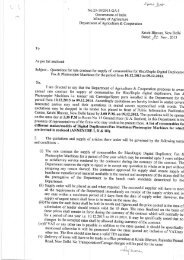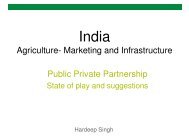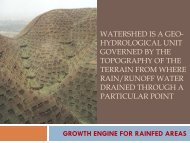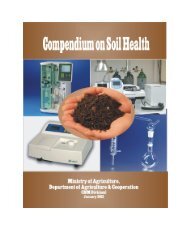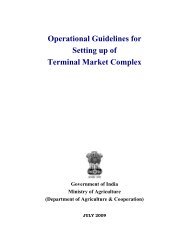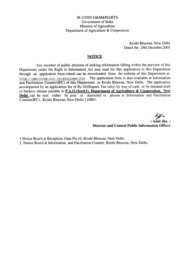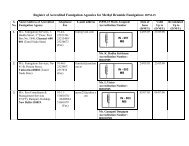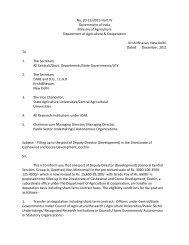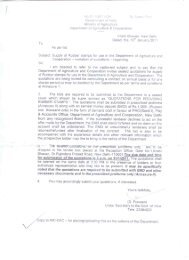Annual Report 2009-2010 - Department of Agriculture & Co-operation
Annual Report 2009-2010 - Department of Agriculture & Co-operation
Annual Report 2009-2010 - Department of Agriculture & Co-operation
You also want an ePaper? Increase the reach of your titles
YUMPU automatically turns print PDFs into web optimized ePapers that Google loves.
<strong>Annual</strong> <strong>Report</strong> <strong>2009</strong>-<strong>2010</strong><br />
26<br />
4.14 The mission aims at increasing the<br />
production <strong>of</strong> rice, wheat, and pulses through area<br />
expansion and productivity enhancement;<br />
restoring soil fertility and productivity; creating<br />
employment opportunities; and enhancing a farmlevel<br />
economy to restore the confidence <strong>of</strong><br />
farmers <strong>of</strong> the targeted districts. The mission<br />
endeavours to enhance the reach <strong>of</strong> proven<br />
technologies and knowledge among the farmers<br />
<strong>of</strong> those districts that have adequate infrastructure<br />
for higher productivity with wider yield gaps.<br />
4.15 The strategy is to enhance the reach <strong>of</strong><br />
proven and established technologies like quality<br />
seeds <strong>of</strong> high yielding varieties and hybrids;<br />
resource conservation and plant residue<br />
management, like the system <strong>of</strong> rice<br />
intensification, zero tillage, and rotavators, and<br />
moisture saving devices; improved seeding in<br />
mono and intercropping systems by using seed<br />
drills, multi-crop planters; plant protection<br />
measures such as knap-sack sprayers, power<br />
weeders, conoweeders; Integrated<br />
Management <strong>of</strong> Pests, nutrients, and weeds; and<br />
capacity building <strong>of</strong> farmers through farmers’<br />
field schools, publicity in print and electronic<br />
media and exposure visits. The award for<br />
performing districts and States is also inbuilt in<br />
the Mission to motivate the field functionaries.<br />
4.16 The beneficiaries <strong>of</strong> the mission include<br />
small and marginal farmers, including women<br />
farmers. The states have been advised to set<br />
aside at least 30 per cent <strong>of</strong> the total allocation<br />
for small and marginal farmers, including women<br />
farmers. Progressive small and marginal farmers<br />
are given preference for seed mini-kits and<br />
demonstrations to create a more visible impact<br />
<strong>of</strong> these technologies.<br />
4.17 Innovative Methods Used: The NFSM is<br />
promoting agricultural technology and best<br />
practices that have been adopted by farmers.<br />
For farmers <strong>of</strong> the NFSM districts, the technology<br />
and related extension methodology has to be<br />
adapted to address the various challenges posed<br />
by the relative under-development <strong>of</strong> the rural<br />
infrastructure, poverty, and under-performing<br />
governance structures operating in these<br />
districts.<br />
4.18 The innovation <strong>of</strong> the mission lies in the<br />
administration <strong>of</strong> the scheme in a way that<br />
ensures the that the planned interventions reach<br />
the beneficiaries at the village level. The mission<br />
makes use <strong>of</strong> existing institutions to carry out its<br />
activities. It aims to strengthen the <strong>Agriculture</strong><br />
Technology Management Agency (ATMA), an<br />
autonomous body already in place with a<br />
mandate to assign specific programmes to<br />
various implementing agencies at the district<br />
level.<br />
4.19 The timely availability <strong>of</strong> funds is assured<br />
through direct transfer to the designated<br />
autonomous agencies at the state and the district<br />
levels. Opportunities are created to leverage the<br />
electronic interconnectivity <strong>of</strong> banks to analyse<br />
transactions <strong>of</strong> the district agencies on the basis<br />
<strong>of</strong> real time data.<br />
4.20 The evolution <strong>of</strong> detailed technical<br />
guidelines, preparation <strong>of</strong> handbooks, and<br />
standard reporting and monitoring formats with<br />
established methodology and periodicity for<br />
systematic reviews have been planned at the<br />
national level.<br />
4.21 For each <strong>of</strong> the identified activities in the<br />
agenda for different programmes, institutional<br />
support is enlisted. This arrangement ensures a<br />
two-way flow <strong>of</strong> ideas to harmonise programme<br />
design as per implementation imperatives and<br />
vice versa. An annual calendar <strong>of</strong> events has been<br />
drawn up to mainstream the action points arising<br />
from regular interaction with the institutions<br />
assigned for different activities.<br />
4.22 Districts are provided with 10 per cent <strong>of</strong><br />
the mission funds for taking up local initiatives<br />
to supplement the other programmes as per the<br />
felt needs <strong>of</strong> the area. Pilot projects have been<br />
provided to promote innovation in programme



